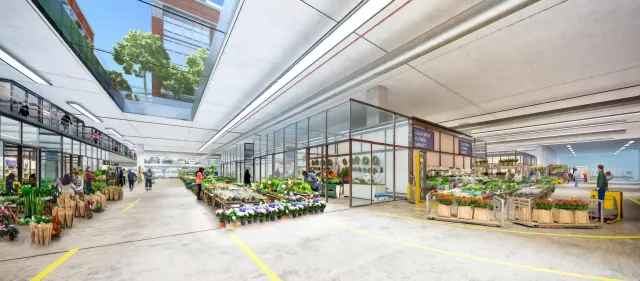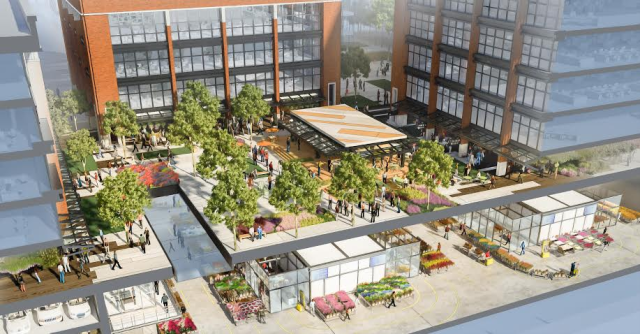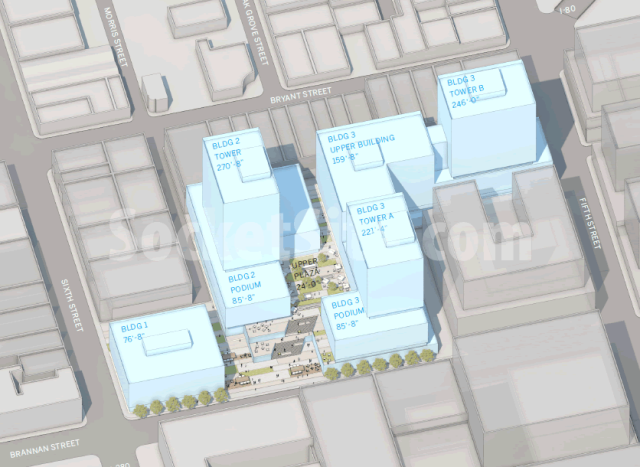Preservation depends on city approval of a project that violates existing law

By Zelda Bronstein
JULY 10, 2015 — On June 26, the San Francisco Flower Market Tenants’ Association signed an agreement with Kilroy Realty and the market’s master tenant, the San Francisco Flower Mart LLC, thereby averting a fight over a November ballot initiative that would have frozen current zoning at the Mart’s longtime Sixth and Brannan location and precluded Kilroy’s proposed highrise office towers on the site.
The deal followed nearly a year of strenuous public and private efforts to save the Flower Mart, a beloved San Francisco institution. Initiated by the flower vendors and led at their request by former Board of Supervisors President Aaron Peskin and former Mayor Art Agnos, the campaign sought to get the Los Angeles-based developer to agree in writing to the vendors’ key demands:
- guaranteed affordable rents
- en masse relocation during construction of a new facility, to be paid for by Kilroy
- exact amount of space to be allocated to the new Mart
- ground floor location of the new Mart
The agreement, which 48 hills has obtained, meets those demands.
That’s a signal achievement. But the Flower Mart’s future is still far from assured.
What the vendors got
Rents
The vendors are sub-tenants of the San Francisco Flower Mart LLC. The agreement involves two subleases, one pre-development, the other post-development.
The pre-development sublease sets the base rents at $1.15 to $1.57 per square foot per month, which matches current rents at the Mart, and tenants’ operating costs at $.10 to $0.15 per square foot.
Starting gross rent at the new Flower Mart will range from $1.65 to $2.25 per square foot per month, averaging at $2.00/sf. Annual rents will increase at roughly 2 percent.
At the June 29 signing ceremony/press conference at the Flower Mart, Kilroy Executive Vice-President Mike Grisso said that the rents were “way below market rate.” According to the commercial real estate brokerage Cassidy Turley, the average asking rent for San Francisco industrial property in the first quarter of 2015 was $1.11/sf/month. Grisso must have been thinking of office rents in the city, which in Q1 averaged $5.34/sf/month.
Relocation
All existing tenants “in good standing” will be relocated as a group to a single location in the city, “to be reasonably determined by KRC [Kilroy Realty] in consultation with the Tenants’ Association and the San Francisco Flower Mart” and subject to final approval by the latter two. The Tenants’ Association pre-approved a location site at 2000 Marin Street, which lies between Highway 101 and Cesar Chavez.
On June 29 Grisso said that the 2000 Marin location has yet to be finalized.
Kilroy will pay for the cost of relocation, including utilities, “connectivity,” and “a materially comparable amount of refrigeration space as exists”—a particular concern of the vendors—in the present Flower Mart.
In a nod to holidays that generate high volume flower sales, the agreement stipulates that “relocation shall only occur between…December 26 through January 31st or February 20th through March 31st or May 15 though October 31st.”
Sub-subleases
The vendors will have the right to enter into subleases pertaining to space at the new Flower Mart without the landlord’s approval. At the Monday event, Peskin emphasized the importance of this provision. Not only does it give “the tenants the ability to pass their leases on to the next generation,” he said. “It also means that “their businesses have value.”
Location of the new Flower Mart location in Kilroy’s project
At the press conference, I noticed that the poster boards on display were the same ones that Kilroy had previously exhibited. They show the new Flower Mart adjacent to the project’s underground parking garage. That surprised me, since both vendors and the San Francisco Flower Mart LLC had pointed out that the ethylene gas emitted by autos damages cut flowers and, accordingly, said that they much preferred a ground level market. Had that request been denied?

Kilroy Senior Vice President Mike Grisso explained that the agreement included both below-grade and ground-level locations, and that the final design would be determined by a secret vote of the tenants. Kilroy will work with a Tenant Project Committee in monthly meetings to discuss and refine the design of the new Mart. According to the agreement, both alternatives include about 115,000 square feet of wholesale warehouse space and about 10,000 sf of retail space.
Customer parking
I also asked Grisso whether the new facility would include parking for the Mart’s customers. He said that Kilroy was planning to double the amount of parking, from the 144 spaces to 300.
The agreement says that the original design includes below-grade parking for up to 150 cars, and that the alternative “modified design” includes the same, but designated for the Marts’ tenants “and their employees and customers.” At the request of the Tenants’ Association, the possibility of additional customer parking—both valet parking and permanent parking on the streets surrounding the new Flower Mart—will be studied.
Governance
The San Francisco Flower Mart LLC will establish a new board of directors to manage the existing Mart, reserving one less than half the seats for members of the Tenants’ Association. SFFM will also establish a grievance procedure for management issues. The Board will create new rules for the new Flower Mart, approve the relocation site, approve new subtenants, and coordinate with Kilroy in connection with the construction of the new market.
What it took
At the Flower Mart, as at the San Francisco Design Center, the essential factor in the light industrial tenants’ success was their ability to join together and press their case.
“I want to salute the tenants,” Peskin said. “They organized themselves”—no easy task, given that they comprised “60 different vendors” with “different ethnicities” and “different histories.” Peskin gave special credit to Louie Figone, the chair of the Tenants’ Association board.
Sup. Jane Kim was also involved, and made a speech at the press conference vowing that no more industrial space would be converted to offices in Soma. “It is critical that we preserve these industrial spaces in SoMa,” she said. “That’s why my office introduced interim controls on office conversions. I plan to fight to ensure that we do not lose one square footage of PDR in Central SoMa.”
That said, the deal with SFFM and Kilroy would not have come to pass without intense community pressure. A poll of likely voters taken last summer found that 78 percent of the respondents wanted to save the Flower Mart. The initiative, whose passage would have maintained the existing 55-feet height limit at the Flower Mart’s current site, needed 9,700 signatures to qualify for the ballot. Kathleen Dooley, the florist and Small Business Commissioner who initially filed the initiative petition with the city, told me that it garnered over 18,000 signatures. The tri-party agreement was signed three days before the deadline for submitting the signatures to the Department of Elections.
It’s not over
Dooley ought to hold on to those names, because—as she’s well aware—the fight to save the Flower Mart is not over.
One problem is that Kilroy is proposing a development that not only exceeds the existing zoning but also busts the height limits at the site in the Planning Department’s draft Central SoMa Plan: 55 feet in the Mid-Rise Alternative; 85 feet in the High-Rise Alternative.
Kilroy originally proposed three 200-foot-plus towers, with an underground Flower Mart:
After the flower vendors objected to the underground location, Kilroy came back with a proposal that had moved the new Mart to the ground level and that made the tallest tower even taller:
A June 29 story on Socketsite contemplated potential obstacles to the city’s approval of either version.
For starters, it appears that some buildings are too tall even for the San Francisco Planning Department:
As we first reported last week, Planning’s preliminary response to the proposed extra height for a 350-foot tower a block away [at 636 Fourth Street] was less than enthusiastic.
Then there’s the always unpredictable electorate:
And Kilroy’s agreement with the tenants doesn’t preclude another ballot measure challenging the spot up-zoning of developments within areas for which a neighborhood plan has already been drafted or adopted from being initiated.
If another initiative does challenge the spot up-zoning that Kilroy seeks or some other integral aspect of the proposed project, it could send the Flower Mart into limbo, as per the concluding sentence in the “Termination” clause of the agreement:
KRC’s obligations and SFFM’s obligations under this Agreement shall terminate immediately in the event the Initiative or any Initiative Alternative would preclude, impede or delay development of the Project as contemplated by this Agreement.
Not incidentally, the Flower Market Tenants’ Association promised both to eschew any action that would “preclude, impede or delay development of the Project” and
to support the development of the Property for the Project, including achieving approvals for at least 1.5 million square feet of new development on the Property, which is necessary in order to fund the construction of the Project (including the New Flower Mart) as contemplated by this Agreement…including providing written support and attending all public hearings as reasonably requested.
What if the city approves a project that’s less than1.5 million square feet or that otherwise substantially differs from what Kilroy has put forward? On that delicate subject, the agreement is mute.
Zoning aside, Kilroy faces another formidable difficulty: the voter-imposed cap on annual office development in San Francisco. Passed at the ballot box in 1986, Prop. M limits approvals of new office development to 950,000 sf per year, with 75,000 sf reserved for small projects between 25,000 and 49,000 sf, and the other 875,000 designated for large projects with at least 50,000 sf of office space.
Currently 2.5 million sf are available for big projects. Every October the city can add 875,000 sf to the Large Allocation Projects pool. This year that addition will bring the total space that can be approved to 3.9 million sf.
But thanks to the tech mania, exacerbated by Mayor Lee’s truckling to the industry, the planning pipeline is now bulging with11.3 million sf of proposed office development, including Kilroy’s 1.54 million sf project at Sixth and Brannan.
As 48 hills has reported, the real-estate industry is showing frustration with the cap. Since last fall, the big developers have been trying to persuade Lee and his planners that the cap could be legally raised by 2.3 million sf without going to the ballot. So far they’ve been stymied. That’s not surprising, given that the November ballot is already carrying five controversial ballot measures and the potentially game-changing District 3 supervisorial race that pits Peskin against incumbent and Lee appointee Julie Christensen.
Pay to Play
Meanwhile, Kilroy is deep into the pay-to-play game. The headline of Matier & Ross’s June 19 column read: “Is developer’s donation rooted in its Flower Mart ambitions?” The writers were referring to Kilroy’s $750,000 contribution to the host committee of the U.S. Conference of Mayors, which took place in San Francisco in mid-June. The money funded the conference’s opening event, hosted by Kilroy “at its downtown rooftop terrace.” Peskin, wrote Matier and Ross,
called the Kilroy kick-in “highly inappropriate,” considering the business that the real estate firm has pending before the city.
“That’s ridiculous,” shot back mayoral press secretary Christine Falvey. “People have been working hard to raise funds and make sure that city taxpayers weren’t left on the hook.” And they won’t be on the hook, she said, “because of the great generosity of the leaders of San Francisco.’’
The $750,000 was “just the latest Kilroy donation to Lee’s pet causes.” In 2013, when “Kilroy was seeking (and eventually got) a city variance to add six floors to its 350 Mission St high-rise, which has been fully leased to Salesforce,” the company gave $1 million to the America’s Cup Organizing Committee.
So we have a powerful developer with strong City Hall ties accepting a landmark deal with tenants that will work only if City Hall gives the developer everything it wants, which is more than the city’s current laws allow. The future of the Flower Mart remains uncertain.




